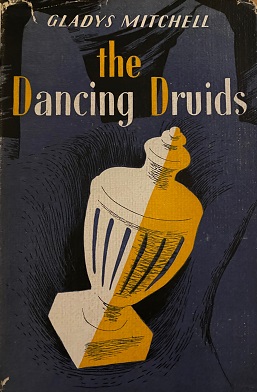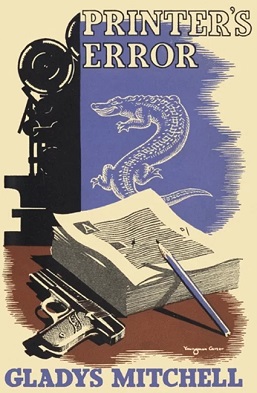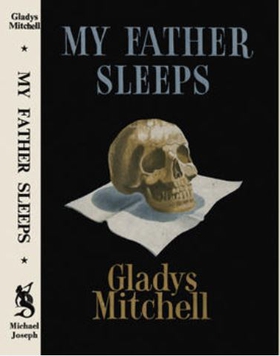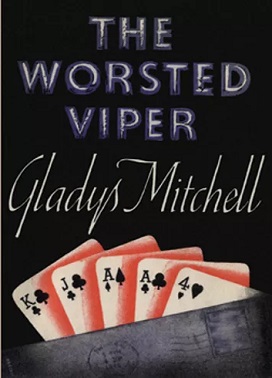
The Devil's Elbow is a 1951 mystery detective novel by the British writer Gladys Mitchell. It is the twenty fourth in her long-running series featuring the psychoanalyst and amateur detective Mrs Bradley. The novel takes its name from a geographical feature along the route of the trip.

Tom Brown's Body is a 1949 mystery detective novel by the British writer Gladys Mitchell. It is the twenty second in her long-running series featuring the psychoanalyst and amateur detective Mrs Bradley. The title refers to both the novel Tom Brown's School Days and the song John Brown's Body. Mitchell had previously used a school setting for her earlier work Death at the Opera.

Faintley Speaking is a 1954 mystery detective novel by the British writer Gladys Mitchell. It is the twenty seventh in her long-running series featuring the psychoanalyst and amateur detective Mrs Bradley.

The Echoing Strangers is a 1952 mystery detective novel by the British writer Gladys Mitchell. It is the twenty fifth entry in her long-running series featuring the psychoanalyst and amateur detective Mrs Bradley.

Death and the Maiden is a 1947 mystery detective novel by the British writer Gladys Mitchell. It is the twentieth in her long-running series featuring the psychoanalyst and amateur detective Mrs Bradley.

The Dancing Druids is a 1948 mystery detective novel by the British writer Gladys Mitchell. It is the twenty-first in her long-running series featuring the psychoanalyst and amateur detective Mrs. Bradley. The title refers to a group of prehistoric stones whose appearance resembles dancing druids.

The Crozier Pharaohs is a 1984 mystery detective novel by the British writer Gladys Mitchell. It is the sixty sixth and last in her long-running series featuring the psychoanalyst and amateur detective Mrs Bradley. The series stretched back to the debut novel Speedy Death in 1929, during which time Bradley had barely aged or changed except for acquiring a damehood. It was published posthumously following Mitchell's death the previous year.

Brazen Tongue is a 1940 mystery detective novel by the British writer Gladys Mitchell. It is the eleventh in her long-running series featuring the psychoanalyst and amateur detective Mrs Bradley.

Here Comes a Chopper is a 1946 mystery detective novel by the British writer Gladys Mitchell. It is the nineteenth in her long-running series featuring the psychoanalyst and amateur detective Mrs Bradley. The title references a line in the nursery rhyme Oranges and Lemons. The plot revolves around a traditional country house mystery involving a man who goes missing only to turn up as a headless corpse.

The Rising of the Moon is a 1945 mystery detective novel by the British writer Gladys Mitchell. It is the eighteenth in her long-running series featuring the psychoanalyst and amateur detective Mrs Bradley. It has been described as one of the best of Mitchell's novels.

Come Away, Death is a 1937 mystery detective novel by the British writer Gladys Mitchell. It is the eighth in her long-running series featuring the psychoanalyst and amateur detective Mrs Bradley. Although the plot revolves around Greek Mythology, the title is taken from a line from Shakespeare's Twelfth Night. It was followed by a loose sequel Lament for Leto in 1971.

Printer's Error is a 1939 mystery detective novel by the British writer Gladys Mitchell. It is the tenth in her long-running series featuring the psychoanalyst and amateur detective Mrs Bradley.

The Longer Bodies is a 1930 mystery detective novel by the British writer Gladys Mitchell. It is the third in her long-running series featuring the psychoanalyst and amateur detective Mrs Bradley.

The Devil at Saxon Wall is a 1935 mystery detective novel by the British writer Gladys Mitchell. It is the sixth in her long-running series featuring the psychoanalyst and amateur detective Mrs Bradley. It was the first of a number of her books to feature the theme of witchcraft, the result of hearing a lecture about it from her friend Helen Simpson who she dedicated the novel to.

Dead Men's Morris is a 1936 mystery detective novel by the British writer Gladys Mitchell. It is the seventh in her long-running series featuring the psychoanalyst and amateur detective Mrs Bradley. It was the first to be published by Michael Joseph who released all the subsequent fifty nine novels in the series. It was later republished with the alternative title Death Comes at Christmas.

Laurels Are Poison is a 1942 mystery detective novel by the British writer Gladys Mitchell. It is the fourteenth in her long-running series featuring the psychoanalyst and amateur detective Mrs Bradley. It was Mitchell's own favourite among her novels and has been considered her best by other critics. It introduced the character of Laura Menzies who became recurring assistant of Mrs Bradley in subsequent novels.

Hangman's Curfew is a 1941 mystery detective novel by the British writer Gladys Mitchell. It is the twelfth in her long-running series featuring the psychoanalyst and amateur detective Mrs Bradley.

When Last I Died is a 1941 mystery detective novel by the British writer Gladys Mitchell. It is the thirteenth in her long-running series featuring the psychoanalyst and amateur detective Mrs Bradley. In a review in The Observer, Maurice Richardson described it as "perhaps Miss Mitchell’s best, most ingenious crime story yet."

My Father Sleeps is a 1944 mystery detective novel by the British writer Gladys Mitchell. It is the seventeenth in her long-running series featuring the psychoanalyst and amateur detective Mrs Bradley. It is set in the Western Highlands of Scotland.

The Worsted Viper is a 1943 detective novel by the British writer Gladys Mitchell. It is the fifteenth in her long-running series featuring the psychoanalyst and amateur detective Mrs Bradley. Bradley was one of a number of investigators active during the Golden Age of Detective Fiction. Much of the novel takes place on the Norfolk Broads.




















